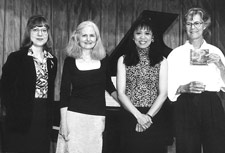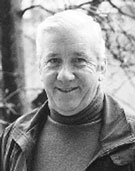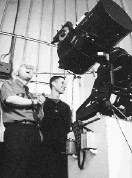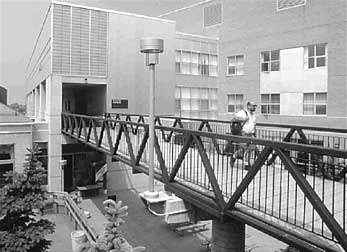 |  |
| | |
| | VOLUME 29, NUMBER 33 | WEDNESDAY, JUNE 9, 1999 | ISSN 1199-5246 | | |
| | ||||||||
|
|
By Michael Todd President Lorna Marsden, other York dignitaries, and York graduates - astronaut Dr. Steve MacLean and CTV news anchor Sandie Rinaldo were among head table guest speakers at the York University Alumni Association's annual general meeting held May 11 in Toronto. York grad, Sandie Rinaldo was keynote speaker. In her talked entitled, "What Is News?," Rinaldo said it's something people in news-making grapple with every day. She defined it as "an event whose effects extend beyond the people involved. But news is only news for a while...like fresh produce it has a limited shelf life." News must have pace, she said. "A volcano is news, but a glacier is not." Of course news reporters are often criticized over their versions of "the truth" or skimpy coverage, but, said Rinaldo, because news happens and breaks so quickly it is at best "the best version of truth in any given moment of time." As for other criticisms that the media incite people to acts of violence through "copy-cat crimes", Rinaldo countered that presupposes a complete lack of free will on the part of individuals. "If someone commits a crime what is copied is only the manner of killing, not the motives or reasons behind it." YUAA president Dale Lastman thanked Rinaldo for her talk, presented her with a gift, and gave notice of the next meeting to take place in "the new millennium."
| |||||||
|
|
By: Andrew McRae Congratulating Petrowska (second from the left) at the CD launch were composers (left to right) Larysa Kuzmenko, Alexina Louie and Ann Southam. Take a moment to peruse your CD collection. Can you find anything produced on the York Fine Arts recording label "Signature Series" - If not, you're missing out. York's label releases CDs featuring some of Canada's leading musical talent. Its latest, Northern Sirens, features York Music Professor Christina Petrowska performing a collection of works written by five Canadian women composers: Larysa Kuzmenko, Alexina Louie, Diana McIntosh, Heather Schmidt and Ann Southham. Petrowska speaks highly of these composers: "[They] have a lot in common. They are Canadian women, consummate musicians, and they know how to play and write for piano. [Their] music is evocative, lyrical, and romantic. Their masterful piano repertoire is a pleasure to perform, and offers its audience a unique listening experience."
Petrowska, an outstanding musician who has established herself as one of Canada's foremost pianists, is recognized internationally as an interpreter of contemporary music. She has premiered more than one hundred works written for her by leading Canadian, American and European composers, appearing in solo recitals and with orchestras on major concert stages and festivals throughout Canada, the US, Europe, the Middle East, Greece, and Taiwan, and on television and radio broadcasts. "I love playing all the works on this CD," said Petrowska. Adding, "Happily - and much to my surprise - the actual recording was done in complete takes in just a few hours, so there remains a concert edge to the performances. Pattern music must have a flow and consistent energy which should not be stopped, and all the pieces have moods which I felt reluctant to desecrate by splicing or sectioning. This is, after all, 'an art of the moment', to be fully enjoyed by playing and listening in the present tense." Northern Sirens is part of an ongoing fulfillment of the Faculty of Fine Arts' determination to profile the talent of people associated with York University, and was produced by Michael Coglan, Chair of the Music Department of the Faculty of Fine Arts.
| |||||||
|
|
Re: York University's transformation from "education factory" to "genuine campus" Christopher Hume, Architect Critic of The Toronto Star is to be commended for drawing attention to the physical maturing of the York Campus in his article of March 25, 1999. He rightly lauds President Arthur's vision and persuasiveness in generating new life in the physical environment - after a ten year stagnation following the Ontario Government's untimely restriction of grants for the construction of buildings. Certainly, the landscaped commons area added an attractive visual dimension to the heart of the campus. The addition of several fine buildings along with a large increase in the student population also enhanced the sense of community. However, Mr. Hume's article contains a number of gross inaccuracies and erroneous conclusions that an experienced architect critic should have avoided. More thorough research and a greater measure of reflection would have revealed: 1. The existence of a carefully developed Campus Master Plan (originally with three dimensional model) based on the understanding of academic needs and physical planning techniques existent some forty years ago. It provided a large measure of flexibility, recognizing the very essence of a university is to establish firm foundations, leaving opportunities for the insertion of new perspectives and societal demands as they inevitably develop over time. 2. The consortium of architects invited by the Board of Governors to develop a long range plan was drawn from three staunchly Canadian firms: one known for its conservatism, one for its leading avant-garde approach and one straddling the other two. The dynamic leader of the unusual partnership later moved to California to prove that a mere Canadian, brought up in the rigours of a northern environment, could make it in the summery atmosphere of the big league in California. In addition, the University benefited from the academic experience and professional judgement of its Planning Consultant, Professor Thomas Howarth, then Dean of the Faculty of Architecture, Urban and Regional Planning and Landscape Architecture, University of Toronto.
3. The concept of an "urban precinct...unthinkable 40 years ago" was, in fact, an integral part of the original Master Plan. Closely placed buildings around pleasantly landscaped courts were designed to provide people places, offsetting the shear magnitude of a multi-faculty campus anticipating an enrolment of 25,000 students. Obviously, such an objective could not be reached immediately, but would evolve in stages over time. In the interim, there would be areas of green awaiting their turn to be transformed into functionally efficient buildings to serve the new frontiers of a vibrant aca-
4. From the outset of a daunting exercise, the master planners recognized the fundamental concept that the scale and form of all buildings should support a learning environment. Never was thought given to erecting "factory buildings" either through lack of understanding of the needs of the University or to save money. Such a concept would have run counter to the heady goals of excellence which have prevailed from York's founding. While many of us were disappointed that the largest building at the centre of the campus did not express exciting architectural qualities, its size and location were intended to reflect the articulated goal of the new University: to emphasize the values and importance of the humanities and social sciences throughout the entire academic collectivity. 5. The limitation of planning and construction time in the early years and the sudden drying up of provincial government grants for building construction. A good example would be two buildings designed by the same architect. The Osgoode Hall Law School had the benefit of an experienced faculty to assist in the preparation of the required statement of program requirements and was spared any major financial constraints. The result, one of the most functionally efficient and attractive buildings on campus. The then Faculty of Administrative Studies Building (now Schulich School of Business) had less preparation time for developing the statement of program requirements and fell victim to declining funding. The result, a structure stripped of several attractive and innovative architectural features. Mr. Hume's musing overlooks the effect of two critical elements - the limitation of time and inadequate funding - in the fruition of a well conceived plan. Hindsight is so much clearer than foresight! As a member of the hard pressed York pioneers, I am proud of participating in the development of the York Master Plan, which incorporated sound core values and built in flexibility for the inevitable but unforeseeable physical changes which the future would require. I am grateful for all those whose fortitude and dedication made possible the addition of approximately five new buildings annually during the first seven hectic years to meet the expectations of the surging influx of students and to support the government in meetings its objectives with respect to higher education. I admire the leadership of the subsequent generation of York leaders whose vision and commitment led to academic advances as well as to the enhancement of the physical surroundings. In turn, I am confident that periodic renewal of leadership will enable the University to meet the changing academic and physical requirements of future generations of enthusiastic students, dedicated faculty and qualified support staff. Tentanda via! (The way must be tried)
William W. Small
| |||||||
|
|
By Cathy Carlyle While most people find that one career is more than enough to occupy them, Peter Ross has managed successfully to juggle several. Ross, special advisor to the Dean, Faculty of Education, has been chosen as 1999 Educator of the Year by a local chapter of Phi Delta Kappa. He asked that his $500 award be given to the LaMarsh Centre for Research on Violence and Conflict Resolution at York University, "as a symbolic gesture of support for its fine work. The centre is particularly valuable in conducting research on the causes and reduction of violence." Reasons for choosing Ross were cited as: his work at York in Field Development; his contribution as Chair of the Board of Governors at Seneca College; and his book, Arresting Violence in our Schools, published in 1998 by the Ontario Public School Teachers' Federation. What is notable about his achievements is that they were accomplished concurrently. "When I was given the award, I kept thinking that I wished my parents were alive to see it happen. My father would have loved it and my mother would have believed it!" joked the affable Ross. He began in the area of education as a teacher at age 18, moved on to became a principal, then an area superintendent for 27 schools in Markham. After that, he was Superintendent of Curriculum for York Region. While carrying out his duties with York Region, he taught a course for York off-campus, called "Models of Education". His association with York strengthened after he retired as curriculum superintendent and arrived here in 1994 as the special advisor to the dean of the Faculty of Education. Over a five-year period, including this past year when he was acting director of Field Development, Ross saw many goals come to fruition. Working with Stan Shapson, dean of Education at the time, and Jill Bell, then associate dean, he negotiated with 17 boards in the Greater Toronto Area to form partnerships for the provision of professional development for teachers. "We managed to bring the boards together in three cooperatives to manage the task more effectively," said Ross. "We asked the boards what was important for us to offer them. York is different from most universities, which offer set courses instead of finding out what is needed," said Ross. York's focus in field development is on education in the community. "We're responsible for the preparation of principals - for helping teachers who want to move up to that position; and for professional development for teachers who might want qualifications in such areas as special education or library." His eyes gleam when the name "Seneca" is mentioned. He was Chair of the Seneca Board of Governors from 1994-98, through all the negotiations alongside the York Board of Governors, leading to the agreement that Seneca College would be permitted to build on York land. "It was a dream when the College was allowed to operate on campus. I was the Seneca Board guy who signed the document. It was a real pleasure for me." His main enthusiasm is for the advantages to students that the arrival of Seneca will bring. "The hope is that this plan will shorten the length of time here for students and will be more cost effective for them. For instance, the dream is that a student may take the practical side of a health sciences program at Seneca and the abstract, academic side at a York Faculty, concurrently." Ross' pride is evident when he talks of being involved in a three-year plan for Seneca, which was operating under "great financial restraints" when he became Chair. "We came out of it with no deficit, which most other boards had. At the end of one year we were hiring again. I was just the Chair. The credit goes to the administration," he said with his customary deflection of praise. Another passion of Ross' is finding ways to stop the violence in schools. In the mid 90s he wrote articles for the Ontario Public School Teachers Federation which were so well-received that he was asked to write a book on the subject, Arresting Violence in Our Schools. "You hear of these crimes committed by young people, like those involved with the murder in BC of Reena Virk, and there's no remorse. That's what we want to change. You have to win their hearts." Arising from his connection with Seneca, Ross was invited to sit on the provincial Police Learning System Advisory Committee. "We make suggestions to the Solicitor-General on how to train people in the police department, from the raw recruit to the police chief, so that it's an articulated system. I know zilch about the police system, but I'm having a lot of fun helping the committee achieve its goals. These goals include raising standards for the preparation of police officers; and making officers more sensitive to the needs of their community." Ross says that if he ever stops sitting on committees - an unlikely occurrence - he'll write more books, particularly ones on developing safe schools and helping children cope with pressure without committing acts of violence.
| |||||||
|
|
At its meeting on April 22, 1999, the Senate of York University:
For further information, please contact the Secretariat at (416) 736-5012.
| |||||||
|
|
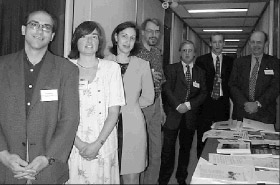 By Nishat Karim From left to right:Yves Roberge (director of Undergraduate Studies, St. George Department of French Studies, University of Toronto), Sheila Embleton (associate dean, Faculty of Arts), Christine Dumont (faculty member), Raymond Mougeon (Chair of French Studies Department), Luc De Volder (Belgian Consul), François Wakahut (representative of French Consulate), George Fallis (dean, Faculty of Arts). It was with great fervour and excitement that the Department of French Studies, Faculty of Arts at York University acknowledged the various works of their professors. Indeed they had a lot to celebrate. On May 20, approximately 30 guests attended a wine and cheese party to honour the research and development activities of faculty members over the past three years. Among the invitees were faculty members, graduating students, the dean and associate dean of arts and external guests such as the local Belgian consulate, the French consulate and deputy minister of education and training. "This is a wonderful occasion not only to celebrate the scholarly work of the Faculty, but also to establish relations with the French speaking community in Toronto," said Dean George Fallis. A display was set up to showcase the numerous accomplishments of thirteen faculty members. Among the commendable works is a linguistics atlas titled The New Romanian Linguistics Atlas, Crisana, complied by Professor Dorin Uritescu. This particular piece received an award from the Romanian Government known as the "B.P. Hasden" which honours works of national and international interest in linguistics. "It's great and very impressive to see so much interesting work here.... I didn't realize how many vast subjects the Department of French Studies covers," said François Wakahut, representative of the French Consulate. The Chair of the French Studies Department, Raymond Mougeon, welcomed the guests and commended the professors who have done outstanding work. Professor Ibrahim Badr was mentioned in particular for receiving the 1999 University Wide Teaching Award. A plaque will be placed in Vari Hall to honour Professor Badr. "This really is a great program. Because it is a small group we have been able to get to know all the professors on a personal level," said Lara Kheir, a graduating student. According to Mougeon this is the first time the department has paid tribute to the hard work of faculty members, but they fully intend to continue recognizing the research, dedication and accomplishments they achieve.
| |||||||
|
|
 Reviewed by Clara Thomas Feminist Spirituality: An Introduction to Feminist Theology in Judaism, Christianity, Islam and Feminist Goddess Worship, by Johanna H. Stuckey, Centre for Feminist Research, York University, Toronto, pp.187, $20.00. In her introduction Johanna Stuckey states her purpose: "It is not my aim to be comprehensive, but to summarize and explicate." She has done exactly that. Feminist Spirituality is an excellent introduction and overview of four world religions from a feminist perspective, valuable to anyone seeking even-handed information and enlightenment about matters of the spirit that effect all of us. It also contains an extensive bibliography, reaching out to others of the world's religions as well as giving an abundance of references to her four major divisions. How much do I know about Judaism when I require students to read Adele Wiseman's Crackpot or many other works? More important, what should I know? What is it my responsibility to know? I would like to see this book on many many reading lists - it makes an excellent religious knowledge introduction to students and faculty alike. A product of years of study and teaching in the field, Stuckey's introductory chapter, "Women's Spirituality" begins from her own experience, the recognition that, increasingly, numbers of women are eager for enlightenment. Her own determination to be even-handed in her treatment is evidenced in the introduction's final paragraphs: "I am not today a follower of any of the forms of spirituality I discuss here. Consequently, I write as an outsider....I have chosen to focus on the traditions that I think have had the most impact in the West. Christianity, Judaism and Islam.... As a scholar of goddess-worship, I also include consideration of one of the fastest-growing new forms of spirituality in the West today: Feminist Goddess Worship." She ends each discussion with its present-day implications for women especially from the point-of-view of feminism and feminist theology. In every case she begins with a short history and goes on to bring the current practices and divisions up to date. For Judaism, for instance, it is extremely useful to know of the beginnings of three major groups, the ashkenazim, sephardim and hasidim and their differences as well as the present-day practices of the orthodox, reform, conservative and reconstructionist divisions. Her final paragraphs deal with women and religious leadership in Judaism, especially with the enormous advances that have been made by feminist theologians, entrenching a tradition of education as well as leadership. Finally she asks the hardest question: if alteration persists, will the final transformation be recognizably Judaism? Beginning with its monotheistic roots, like Judaism's in the covenants God made with the people of Israel, she deals with the radical break from Judaism that Christianity represents and goes on to describe its three major divisions and the beliefs basic to them: eastern orthodoxy, Roman catholicism, and protestantism. Under these we have a division between "liberal" and "conservative" protestantism with thumb-nail sketches of their best-known sub-divisions. Under the wide umbrella of Christianity women were very early to become prominent in the gospels as well as in accounts of the early church. Today most branches of protestantism are alive with activity from sober enquiry to passionate revolt, seeking to disengage their worship from the prejudices and discriminations that have hampered them and continue to do so. In strong opposition to reform there is the disquieting tendency for the most conservative to follow the recent declaration of the southern baptist convention, the largest protestant denomination in the USA, that women should "submit graciously" to the leadership of their husbands. The inevitable human weakness of splitting into factions, often warring factions with their over-riding political agendas, produces a fascinating, though frustrating spectacle. Then too, there is finally the same hard question to be asked: Will a transformed religion still be recognizably Christian? Islam is immensely more complicated for an outsider either to summarize or to grasp than either Judaism or Christianity. Partly this is because, relative to the other two, it is a recent religion - Muhammad lived from 570 CE (Christiam Era) to 632 CE. Already in his lifetime he had set out upon the path of conquest that was to define Islam henceforth, subduing Mecca, his home city, and sanctifying the Kaaba, the Black Stone of Mecca, already for centuries a sacred object. Unfortunately, he neglected to name his heir before death, setting in train controversy among his relatives (he had daughters but no living sons) that eventually resulted in the separation of Islam into shiite and sunni Muslims, with sufism, Islamic mysticism, ascetic in its origins. By the 15th and 16th centuries, a large part of the Islamic world belonged to three empires: Persia, officially shiite in religion, north India, where the Mughal dynasty practiced sunni Islam, and the Ottoman empire, also sunni, finally comprising Algeria, Tunisia, Cyprus, Egypt, Syria, Turkey, Iraq and western Arabia. Although there is considerable mixing of the two branches among the world's Muslims, the divisions in general remain. Stuckey lists Islam's chief tenets as these: "First and foremost, Islam is monotheistic... further characterized by lack of separation between sacred and secular; for practising Muslims, their religion IS their way of life." Their articles of faith comprise oneness, prophethood, the quran, life after death, a world community of Islam and finally, jihad, meaning "struggle", first against evil, then against polytheists. The quran, derived directly from God, is more than a sacred book; it is "coextensive with God" and Muslims live under its authority. There is a wide variety in practices, laws and rituals involving or excluding women. However, since the United Nations' Convention Against All Forms of Discrimination Against Women was ratified by many countries in 1981, including many Islamic countries, by January of 1995 forty-two countries had declared reservations with the convention, and these include twelve predominantly Muslim. In recent decades, a surge of nationalism in many areas has resulted in a great increase in women wearing the "hijab" or veil to demonstrate at once their commitment to Islam and their opposition to western imperialism. It is not surprising that the feminism of the western world is rejected by many of Islam's woman activists, or that they advocate working within their own societies to make the changes they see as necessary. "There is one way, perhaps only one way, for a Muslim woman to criticize Islam without having to face the charge of being a 'Western-inspired lackey'. that is to call herself an 'indigenous feminist', an Islamic feminist." Inevitably it follows that a writer or reader from the west finds enormous difficulty in assessing the actual state of Islamic status of women affairs. It is easy, and sad, however, to point to obvious offences against women by such fundamentalist "revivalist" groups as the Taliban movement in Afghanistan which, in 1996, began to impose a strict reading of Islamic law on the population with men and women obliged to be covered head to toe in public, and women forbidden to work outside the home except in medicine. Goddess Worship has occurred for thousands of years, as scholars have abundantly demonstrated, but in our time it is the most recent of important feminist religious movements. Only recently has it differentiated itself from other groups, particularly Wicca. Because its practices are widely varied and its basic tenets are anything but stable, it is the most difficult of the four to encapsulate. There are, however, certain principles common to Feminist Goddess Worship: Femaleness is central to their beliefs, combined with a rejection of the body/mind-spirit dualism of Western culture. Female empowerment is their primary aim, Nature is alive and sacred, tolerance of other's views is a given, the sacred history of Goddess Worship is accepted, and finally, decentralization and lack of hierarchy are absolute rules. Consequently, each group, however small, is free to set up its own practices and rituals - and rituals are a very important part of the dynamic of the believers. Like the other religions, Goddess Worship is open to factionalism and disagreement, about political involvement, the role and status of men, their inclusion or exclusion, or the eventual possible fashioning of a truly woman-centred culture. What is abundantly evident to both practitioners and observers of Goddess Worship is its move towards healing, of the self first and then of the entire society - an often powerful movement towards order, community and cultural transformation. As Stuckey began her study from a feminist viewpoint, though one uncommitted to any of the religions she treats, so she ends with her own conviction and the assurance that spirituality and religion have become a lasting and powerful part of the feminist agenda. This is a wise and a hopeful book - it is also an extremely valuable one. Clara Thomas is a professor of English in the Faculty of Arts at York University.
| |||||||
|
|
By Cathy Carlyle Paul Delaney, left, said people at the York Astronomy Day open house stayed well past the scheduled time, so keen were they to view the dark night sky through one of the several telescopes. About 50 members of the public trekked to the York Observatory on May 19, International Astronomy Day, to be awed by outer space. Although the open house at the observatory was scheduled to run from 4 to 9 pm, some people could not tear themselves away until 11:30.
"It was great! They really wanted to see the planets and stars through the telescopes when it was completely dark out, so they stayed," said Paul Delaney, Master at Norman Bethune College and Observatory Coordinator in the Department of Physics and Astronomy. "Part way through the evening I had about 25 at my lecture about Mars, which was mainly about where exploration of the planet is today and what we can expect in the future. There was a lot of interest in the subject and lots of questions." According to Delaney, Astronomy Day has been celebrated for about 10 years in an organized way throughout most of the world. He introduced the idea of marking the day at York about a decade ago, and continues to organize it. "But I could not possibly do it alone. My observing team makes the day work. This year I had Houman Khosrovani, an undergraduate, and Mel Blake, a grad. student, helping in its organization. I want to give special thanks, too, to Julie Tome, Ryan Jarvis, Darren Craig and Professor Jim Laframboise for their participation in this event." The Observatory is open to the public every Wednesday, year round. People may obtain more information on the York Astronomical Observatory Web site at www.physics.yorku.ca/News Events.htm or by phoning the information line at (416) 736- 2100, ext. 77773.
| |||||||
|
|
By Nishat Karim Calumet College: First Nations peoples in Upper Canada use a unique rock to make ceremonial pipes. In French, this rock is known as calumet and pipes made from it are considered symbols of peace. When the Fellows of Calumet chose their name in 1971, they felt the word "peace" best represented themselves. Hence, College "F" which was born in 1970, became known as Calumet College. For many years though, Calumet did not have a place of its own. Its life began during the summer of 1970, in the corner of Steacie Science Library. Shortly after, the College relocated to the first floor of Atkinson College where it was housed for 20 years. The community of Calumet decided they wanted an alternative to the predominantly residential college style at York. Instead of taking their place in the sixth college building, they presented it to College "G" - now known as Norman Bethune College. Calumet then began planning a new academic/residential complex from scratch. In 1991, the long awaited Calumet College and Residence were built. Rather than use a flag to represent itself like the other Colleges at York, Calumet uses a ceremonial rock, representing a symbol of peace, to mark its place on campus.
| |||||||
|
|
| | ||||||
| | Current Issue | Previous Month | Past Issues | Rate Card | Contact Information | Search |
|

